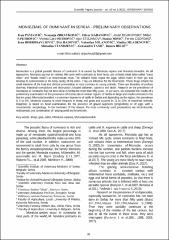Monieziais of ruminant in Serbia - preliminary observations
| dc.contributor.author | Pavlović, Ivan | |
| dc.contributor.author | Zdravković, Nemanja | |
| dc.contributor.author | Radanović, Oliver | |
| dc.contributor.author | Bojkovski, Jovan | |
| dc.contributor.author | Petrović, Milan | |
| dc.contributor.author | Caro-Petrović, Violeta | |
| dc.contributor.author | Stojanov, Igor | |
| dc.contributor.author | Minić, Stanko | |
| dc.contributor.author | Csordás, Ferenc | |
| dc.contributor.author | Dobrosavljević, Ivan | |
| dc.contributor.author | Radović, Bisa | |
| dc.contributor.author | Milanović, Valentina | |
| dc.contributor.author | Mladenović, Vladica | |
| dc.contributor.author | Stanojević, Slobodan | |
| dc.contributor.author | Tasić, Aleksandra | |
| dc.contributor.author | Relić, Renata | |
| dc.date.accessioned | 2023-05-25T11:35:59Z | |
| dc.date.available | 2023-05-25T11:35:59Z | |
| dc.date.issued | 2022 | |
| dc.identifier.issn | 1454-7406 | |
| dc.identifier.uri | https://repo.niv.ns.ac.rs/xmlui/handle/123456789/620 | |
| dc.description.abstract | Monieziais is a global parasite disease of ruminants. It is caused by Moniezia expans and Moniezia benedini. As all tapeworms, Moniezia spp has an indirect life cycle with ruminants as final hosts, and oribatid mites (also called "moss mites" and "beetle mites") as intermediate hosts. The oribatid mites ingest the eggs, which hatch in their gut and develop to cysticercoids in the body cavity of the mites. They are infective for the final hosts. These thugs inhabit the small intestine of the host and clinical presentation is most common in young animals. There are disorders of profuse diarrhea, intestinal convulsions and obstruction, bloated abdomen, cachexia and death. Research on the prevalence of monieziais in ruminants has not been done in Serbia for more than fifty years. In our work, we presented the results of a preliminary examination of the prevalence of monieziais in certain regions of Serbia in large and small ruminants in the last ten years. Moniezia benedeni is a common tapeworm of cattle in Serbia and depending on the region, the prevalence is 3 to 5%. Moniezia expansa is more frequent in sheep and goats and occured in 11 to 23% of examined animals. Diagnosis is based on fecal examination for the presence of gravid segments (proglottids) or of eggs with a characteristic morphology. In the treatment of the disease, the most commonly used preparations are bezamidazole, niclosamide, and combination of praziquantel and levamisole. | en_US |
| dc.description.sponsorship | The study was funded by the Serbian Ministry of Education, Science and Technological Development (Contract No 451- 03-68/2022- 14/200030). | en_US |
| dc.language.iso | en | en_US |
| dc.source | Scientific Papers Journal Veterinary Series | en_US |
| dc.subject | sheep | en_US |
| dc.subject | goat | en_US |
| dc.subject | cattle | en_US |
| dc.subject | Moniezia expansa | en_US |
| dc.subject | Moniezia benedini | en_US |
| dc.title | Monieziais of ruminant in Serbia - preliminary observations | en_US |
| dc.type | Article | en_US |
| dc.citation.volume | 65 | en_US |
| dc.citation.issue | 3 | en_US |
| dc.citation.spage | 39 | en_US |
| dc.citation.epage | 42 | en_US |
| dc.citation.rank | M53 | en_US |
| dc.type.version | published | en_US |
Files in this item
This item appears in the following Collection(s)
-
Naučni radovi
Radovi objavljeni u naučnim časopisima

